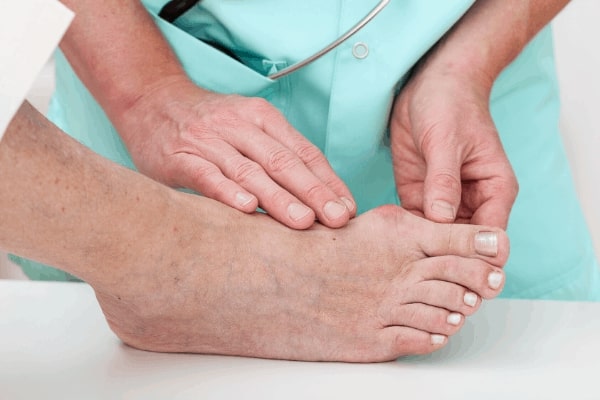Bunion pain can have a negative effect on your day-to-day life, making it hard to walk and go about your daily activities. Explore some of our advice on treating bunion pain to ease the discomfort and get back to normal.

What is a bunion?
A bunion (hallux valgus) is a bony lump that forms on the inside of your foot at the base of your big toe joint. This can affect your big toe by pushing it to point excessively towards your second toe.
Are bunions sore?
Other symptoms include:
- Pain and soreness
- Numbness
- A burning sensation in the foot
- Swelling in the foot
- Hardened skin on the bottom of your foot
- Redness over the lump
- Restriction of the affected toe
Not sure if it’s a bunion?
Here are some other foot problems that might be causing your pain:
- Gout – redness, heat, swelling and pain that comes and goes
- Arthritis – aching, swollen and stiff; usually worse in the morning
- Broken toe – pain, bruising and swelling after hurting your toe
Treatment for bunion pain
Discover some of the treatment options to prevent your bunion from worsening…
Wear wider, supportive footwear
Avoid narrower shoes and high heels, instead wear wide, flat shoes with a soft sole. Flat shoes help to take pressure away from your big toe and create more space to help relieve your bunion pain.
Cushion and protect
Bunion pads (soft pads that go over your bunion) or shoe inserts help to ease painful bunion pressure.
Soothe swelling with an ice pack
Apply an ice pack wrapped in a tea towel to the affected area when you can. This will help to ease the pain of a bunion and help to reduce the swelling.
Bunion pain relief
Take paracetamol or ibuprofen to help reduce the pain and the inflammation.
Lifestyle changes
Try losing weight if you are overweight. Being overweight can put a lot of pressure on your feet, which can lead to bunions developing.
Try a bunion splint
Wear a bunion splint at night to help gradually push the toe back into its normal alignment. This will not get rid of your bunion but rather help with the positioning of your toe.
Bunion surgery
If the pain in your bunion does not go away, your doctor may recommend surgery, which is the only way to get rid of a bunion.
Bunion surgery is called an osteotomy, which usually takes less than an hour and is usually done under general anaesthetic.
The surgery is undertaken by making a small cut in the skin over your big toe, cutting or scraping away the bunion and then returning the toe bone to its correct position using metal screws or staples put under your skin. These will often be left in the toe permanently.
Unfortunately, bunions can sometimes naturally come back even after surgery.
Preparing for bunion surgery
- Make sure your home is crutch friendly before you leave for your operation, moving any furniture to create more space to move around in. Also, make sure everything you need is within reach.
- Arrange for someone to take you home after the surgery and help you out the first few days.
- Stock up on easy to make meals like tinned or frozen food.
- Before your operation your doctor may ask you not to eat or drink to avoid any complications while you’re under general anaesthetic.
- If you are a smoker, try to stop before the surgery as smoking can put you at risk of getting a wound infection and slow down your recovery rate.
After your bunion surgery
You will usually be given crutches after your surgery and you may be wearing a splint, plaster cast or special shoe.
To help with your recovery:
- Try to avoid being on your feet for too long for at least 2 weeks
- Do not drive for at least 6 to 8 weeks
- Avoid work for 6 to 12 weeks
- Avoid sports for up to 6 months
Once you have recovered you may see some differences in your big toe, it might be weaker or stiffer than before, it may not be perfectly straight and there’s a chance you may have to keep wearing wide, comfy shoes. From the surgery you may still feel sore and you may have swelling in your foot which can take up to six months to a year to reduce.
If you are suffering from bunion pain, fill in our enquiry form on the right to find out more about getting foot surgery at one of our treatment centres.

